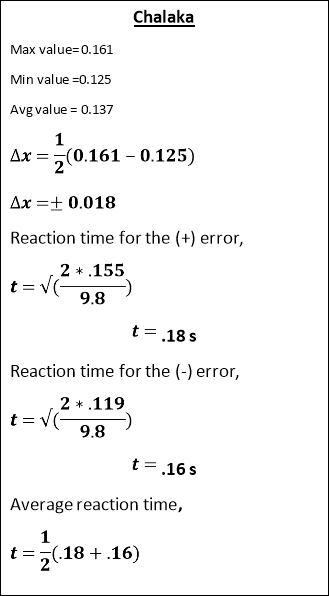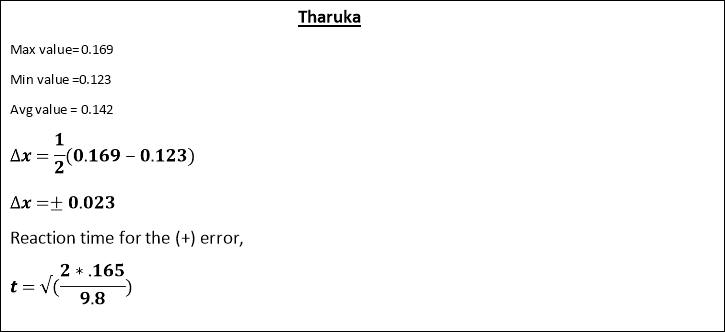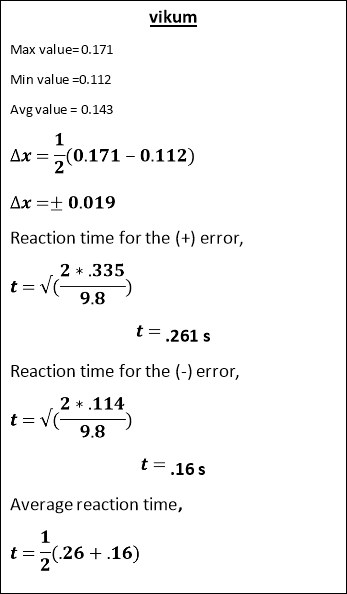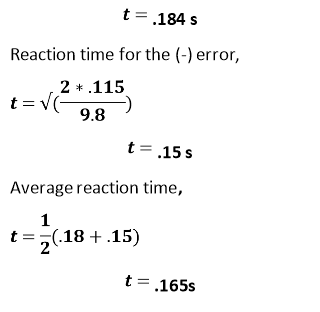Ruler Dropping Test to Measure Reaction Time
| ✅ Paper Type: Free Essay | ✅ Subject: Engineering |
| ✅ Wordcount: 1031 words | ✅ Published: 30 Aug 2017 |
Problem statement
It takes every person a little time to react to any event. For example, there is a small delay before you try to catch a ball moving towards you or trying to catch a falling glass from a certain height. This time is called your reaction time.
There are many ways that you can measure your response time. Some of the methods are very easy (without calculation). One of the simplest and common methods of calculating response time is the ruler drop test. Most of the athletes use this methods to calculate their response time.
In our engineering physics class we were asked to use this method to calculate our reaction time. For this assignment we were to be in small groups and measure everyone’s reaction time by getting 10 measurements from each student and determine who has the fastest reaction time. After taking the initial measurements we were also tasked to calculate the errors of those measurements.
Coming up with a plan to asses this we encountered some major problems such as,
- How fast is our reaction time?
- With each measurement does our reaction time increase?
- Why we tend to catch the ruler in the middle rather than the beginning?
- How to improve our reaction time?
After we have done this assignment we plan to solve each one of those questions while providing the answers to our assignment.
What is reaction time?
In this method one of the students drops the ruler, the student see it starts to move and nerve signal travels from his eye to his brain. The brain simulates the signal and sends it to his finger muscles which move to catch the ruler. The whole process takes between 150 and 220 milliseconds.
The process of catching the dropped ruler begins with the eye watching the ruler expecting of it falling. After the ruler is dropped, the eye sends a message to the visual cortex (which simulates what we see), which perceives that the ruler has dropped and its falling. Then the visual cortex sends a message to the motor cortex (nerve stimulation) to start the process of catching the ruler. The motor cortex sends a message to the spinal cord, which sends a message to the muscle in the hand/fingers. The final process is the process that makes a muscle to become tighter of the muscles as the hand grasps the ruler. All of these processes involve individual neurons that transmit electrochemical messages to other neurons.
How to proceed the test.
- What do we need?
- An accurate ruler.
- Two people(one to release the ruler and one to catch it)
How to proceed.
When we do this test one person has to hold the ruler and release that ruler at an unpredictable time. When the ruler start to fall (the test) the other person (test subject) has to pinch his fingers together catching it. This is his reaction to the falling ruler. The distance that we take (to measure) is the distance between the bottom of the ruler and the top of the thumb where the ruler has been caught. It is very unlikely that a student can stop the ruler at the same distance twice in a row. That means that we can get a more accurate measure of that student’s reaction time. We are conducting this experiment several times and take an average of our results. For this assignment we take 10 measurements from each student.
How to calculate.
To calculate ones reaction time we use the 3rd kinematic equation,

 1
1
- s= displacement.
- u= initial velocity.
- t=time taken.
- a=average acceleration.
Proving,
 To prove the 1st equation,
To prove the 1st equation,



 2
2
We know that the first kinematic equation is,

Applying this to the 2nd equation,




How to use this to calculate reaction time
Because the ruler is dropped down,












Calculation
To calculate the reaction time for each person we took 10 measurements from each person to get an accurate value. To get the most accurate value we calculated the mean of each person. Down below are the measurements we got.
- Every value is on cm scale.

As proven above we are going to use two equations to calculate each ones reaction time and determine who has the fastest reaction time.


 1
1
 2
2









Looking at the results we found, we can see there are four people with a reaction time of 0.165s. This brings the idea of errors in this calculation and method. What can be the errors in this measuring method?
- Thought processing speed is different in each individual. As I explained above when I was describing reaction time to catch the ruler the test subjects muscle has to work. Depending on the thought processing speed it varies. Because we are taking average metes of each person you can see all the averages are on the same range. That means even if one person went too far with the meters he can catch up with others with fast reaction time.
- Other thing is because the measuring system is analogue, people can make mistakes such as the person who is dropping the ruler is not consistent with his work (dropping the ruler). That can lead to errors.
Conclusion
Ruler dropping test can be the easiest way of measuring reaction time but it has its own pros and cons. This method requires very minimal amount of items to conduct the test. This method also not require a specialized pace to conduct the test and can be easily set up for the test. However there are few disadvantages as well such as this requires at least one assistant to support the test subject. Also because it’s simple it can be incorrect when it comes to the calculations as we can see above. In our given assignment we were to find a way to measure the reaction time using the ruler drop test. This leaves us with only one question, is it reliable to measure our reaction time with this method?
REFERENCES
- [1]B. Mackenzie, “Ruler Drop Test”, Brianmac.co.uk, 2017. [Online]. Available: https://www.brianmac.co.uk/rulerdrop.htm. [Accessed: 22- Mar- 2017].
- [2]”File:REACTION.DOC”, Physics.nmsu.edu, 2017. [Online]. Available: http://physics.nmsu.edu/research/lab110g/html/AREACTION.html. [Accessed: 22- Mar- 2017].
Cite This Work
To export a reference to this article please select a referencing stye below:
Related Services
View allDMCA / Removal Request
If you are the original writer of this essay and no longer wish to have your work published on UKEssays.com then please click the following link to email our support team:
Request essay removal


